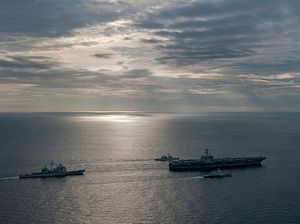As I noted in an earlier piece, Malaysia looks set to cut its defense budget for next year by 2.25 percent according to figures unveiled by Prime Minister Najib Razak in an annual speech to the nation October 23.
Specifically, the amount allocated for defense was just 17.3 billion ringgit ($4 billion), a decrease of 2.25 percent relative to the 17.7 billion ringgit allocated for 2015 (See: “Malaysia Cuts Military Budget for 2016 Amid Economic Woes”).
As I pointed out before, the decrease itself is not surprising to close observers of the Southeast Asian state, particularly given severe concerns about the economy. Growth, already sluggish this year due to falling commodity prices and a state investment fund scandal implicating Najib himself, is expected to slow even further to between 4 and 5 percent next year. The Malaysian ringgit has been Asia’s worst-performing currency this year, losing more than a fifth of its value against the U.S. dollar. Spending on defense in Malaysia, which has fallen victim to politicization in the past, is even less popular at a time of economic distress.
But the defense budget cut is still likely to play into the existing narrative that budget constraints are preventing the country from meeting its growing defense needs. Numerically, as far as year-on-year increases go, a 2.25% percent decrease from 2015 to 2016 is quite a dramatic figure relative to the 10 percent increase we saw from 2014 to 2015.
Beyond the numbers, those who follow Malaysian security developments closely know that it suggests that the yawning gap between what defense officials say the country requires and what the government is willing to fund shows few signs of closing anytime soon. A series of crises over the past few years – including the invasion of Filipino militants in the eastern part of the country in 2013, the disappearance of Malaysian Airlines flight MH 370 in 2014, and growing intrusions in Malaysian waters by China – have only confirmed that the country’s weak capabilities are woefully inadequate for dealing with the challenges it currently confronts (See: “Malaysia Responds to China’s South China Sea Intrusion”).
To be sure, it is unwise to look only at a single year and a gross amount rather than as a percentage of GDP. Malaysia’s defense spending as a percentage of GDP for 2016 looks to remain roughly at 1.5 percent – around the same level that it has been over the past few years. Furthermore, defense planning is a multi-year process such that certain acquisitions can be moved further down the road rather than being canceled altogether. The 2016 defense budget is only the first under the new 11th Malaysia Plan which runs from 2016 to 2020.
Furthermore, previously announced procurements still look to be prioritized now in spite of the budget trim. As Najib himself noted in his speech, the budget level will not affect the acquisition of equipment critical to boosting the country’s aerial and maritime capabilities, including six Second Generation Patrol Vessel – Littoral Combat Ship (SGPV-LCS) vessels, Starstreak ground-based air-defense missile systems, and the Airbus A400M Atlas transport aircraft.
Priority is also being given to equipping the Malaysian armed forces with the latest technology, including the use of unmanned airborne system to improve intelligence, surveillance and reconnaissance (ISR) capability as well as 523 million ringgit for developing an ESSCOM armed forces camp in FELDA Sahabat, Lahad Datu, Sabah. This has been a priority area since the 2013 invasion by Filipino militants in the so-called Lahad Datu incident (See: “Malaysia Eyes Submarine Base Expansion Near South China Sea”).
One technical point often missed by some observers regarding Malaysia’s defense budget process is that the 17.3 billion ringgit allocation often cited only includes the money for the Malaysian armed forces, and not the separate allocations for the Malaysian police and Malaysian Maritime Enforcement Agency (MMEA) – the country’s equivalent of a coast guard. Both these agencies play a significant role in preserving the country’s security.
For example, the MMEA was allocated RM864 million, which includes funding for the acquisition of offshore patrol vessels and patrol boats. As I have stressed elsewhere, strengthening Malaysia’s coast guard capabilities well help it deal with a variety of threats it is confronts in its vast maritime space (See: “Malaysia’s Approach to the South China Sea: Playing it Safe”).
That said, concerns will likely continue to linger about the impact of the country’s economic turmoil on its defense spending. As it is, the Malaysia’s lagging capabilities have been repeatedly exposed in the face of the manifold threats the country faces, including piracy, smuggling, kidnapping, terrorism, illegal fishing, and encroachments by regional neighbors like Indonesia and the Philippines. Meanwhile, new defense programs which were mulled to help close gaps had already been shelved due to budgetary constraints. The current political and economic environment makes it even more difficult to fund much-needed capability boosts. As we move further into the new 11th Malaysia Plan, observers will be looking to see whether Malaysia’s leaders are able to continue to make the necessary investments to meet the country’s urgent defense needs.
































